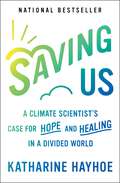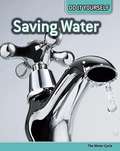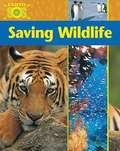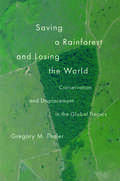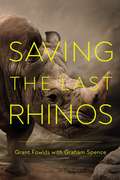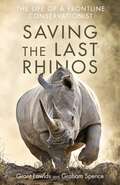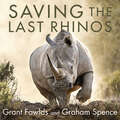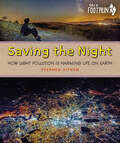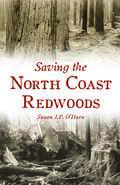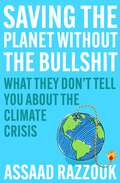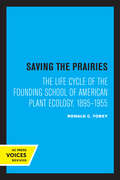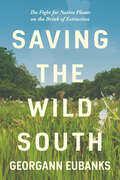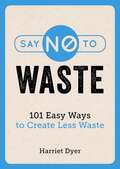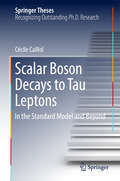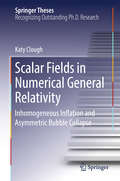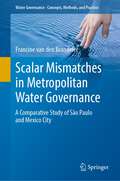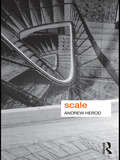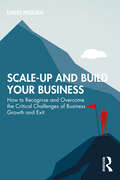- Table View
- List View
Saving Us: A Climate Scientist's Case for Hope and Healing in a Divided World
by Katharine HayhoeUnited Nations Champion of the Earth, climate scientist, and evangelical Christian Katharine Hayhoe changes the debate on how we can save our future in this nationally bestselling &“optimistic view on why collective action is still possible—and how it can be realized&” (The New York Times).Called &“one of the nation&’s most effective communicators on climate change&” by The New York Times, Katharine Hayhoe knows how to navigate all sides of the conversation on our changing planet. A Canadian climate scientist living in Texas, she negotiates distrust of data, indifference to imminent threats, and resistance to proposed solutions with ease. Over the past fifteen years Hayhoe has found that the most important thing we can do to address climate change is talk about it—and she wants to teach you how. In Saving Us, Hayhoe argues that when it comes to changing hearts and minds, facts are only one part of the equation. We need to find shared values in order to connect our unique identities to collective action. This is not another doomsday narrative about a planet on fire. It is a multilayered look at science, faith, and human psychology, from an icon in her field—recently named chief scientist at The Nature Conservancy. Drawing on interdisciplinary research and personal stories, Hayhoe shows that small conversations can have astonishing results. Saving Us leaves us with the tools to open a dialogue with your loved ones about how we all can play a role in pushing forward for change.
Saving Water: The Water Cycle
by Buffy SilvermanHow much water should you drink in a day? Where does rain go? How does water shape the land? Do It Yourself offers an exciting new approach to understanding and investigation. Each book helps you to conduct your own experiments and activities, and to learn more about the world around us.
Saving Wildlife (Earth SOS)
by Sally MorganOffering information at multiple levels for several reading levels, this series describes the many dimensions of wildlife depletion and its related problems that accompany global warming and mankind's abuse of the environment. The interdependence of all the natural systems in the world are stressed in the book. This volume concludes with a fact file and suggestions for the reader on how to improve the environment.
Saving a Rainforest and Losing the World: Conservation and Displacement in the Global Tropics (Yale Agrarian Studies Series)
by Gregory M. ThalerAn unflinching investigation of the false promises of land sparing, exposing how its illusory successes mask the failures of green capitalism For two decades, the concept of land sparing, the claim that agricultural intensification can spare land by preventing forest clearing for agricultural expansion, has dominated tropical forest conservation. Land sparing policies transform landscapes and livelihoods with the promise of reconciling agricultural development with environmental conservation. But that land sparing promise is false. Based on six years of research on agrarian frontiers in Indonesia, Brazil, and Bolivia, this book traces where and how land sparing becomes policy and charts the social and ecological effects of these political contests. Gregory M. Thaler explains why land sparing appears successful in some places but not in others and reveals that success as an illusion achieved by displacing deforestation to new frontiers. The failure of land sparing exposes a harsh truth behind assurances of green capitalism: capitalist development is ecocide.
Saving the Last Rhinos: The Life Of A Frontline Conservationist
by Graham Spence Grant FowldsThe remarkable story of Grant Fowlds, who has dedicated his life to saving the imperiled rhinos, vividly told with Graham Spence, co-author of the bestselling The Elephant Whisperer.What would drive a man to &‘smuggle&’ rhino horn back into Africa at great risk to himself? This is just one of the situations Fowlds has put himself in as part of his ongoing fight against poaching, in order to prove a link between southern Africa and the illicit, lucrative trade in rhino horn in Vietnam. Shavings of rhino horn are sold as a snake-oil &“cures,&” but a rhino&’s horn has no magical, medicinal properties whatsoever. Yet it is for this that rhinoceroses are being killed at an escalating rate that puts the survival of the species in jeopardy. This corrupt, illegal war on wildlife has brought an iconic animal to the brink of extinction. Growing up on a farm in the eastern Cape of South Africa, Grant developed a deep love of nature, turning his back on hunting to focus on saving wildlife of all kinds and the environment that sustains both them and us. He is a passionate conservationist who puts himself on the front line of protecting rhinos in the wild—right now, against armed poachers—and in the long term, through his work with schoolchildren, communities, and policymakers.
Saving the Last Rhinos: The Life of a Frontline Conservationist
by Graham Spence Grant Fowlds'A terrific read . . . an outstanding book!'Gary Player and Vivienne Player'A truly heart-wrenching story, but a must-read for all who value our wild animals and their right to roam free. Grant Fowlds is a Zulu in a white skin and loves the people who hold the key to animal conservation. This is an intriguing true story that sends a clear message to the rest of the world.'Phil Liggett'Exceptionally readable - a fluid and captivating story . . . a swashbuckling tale.'Dr Dave Cooper, Rhinos Without Borders veterinarian, and Debbie Cooper of iSimangaliso Wetland Park'A rollicking true-life adventure that celebrates rhinos and people'Guy Rogers, Daily Herald'Truly awe-inspiring . . . Read this book. You will get a sense of Africa like never before, from a true African soul.'David S. Lee, Limbani in the blockbuster movie Black Panther'An excellent read . . . both sobering and uplifting'Moira Smith, General Manager Africa & Middle East, Goway TravelWhat would drive a man to 'smuggle' rhino horn back into Africa at great risk to himself? This is just one of the situations Grant Fowlds has put himself in as part of his ongoing fight against poaching, in order to prove a link between southern Africa and the illicit, lucrative trade in rhino horn in Vietnam.Shavings of rhino horn are sold as a snake-oil 'cure' for colds or impotence, but a rhino's horn has no magical, medicinal properties. It is for this that rhinoceroses are being killed at an escalating rate that puts the survival of the species in jeopardy. This corrupt, illegal war on wildlife has brought an iconic animal to the brink of extinction.Growing up on a farm in the Eastern Cape of South Africa, Grant developed a deep love of nature, turning his back on hunting to focus on saving wildlife of all kinds and the environment that sustains both them and us. He is a passionate conservationist who puts himself on the front line of protecting rhinos in the wild - right now, against armed poachers; but in the longer term, too, through his work with schoolchildren, communities and policymakers.We are most grateful to photographer Gerhard van der Westhuizen for the use of his stunning photograph on the cover of the book.
Saving the Last Rhinos: The Life of a Frontline Conservationist
by Graham Spence Grant FowldsThe remarkable story of Grant Fowlds, a conservationist who has dedicated his life to saving the last rhinos, vividly told with the help of Graham Spence, co-author of the bestselling The Elephant Whisperer.'A terrific read . . . an outstanding book!'Gary Player and Vivienne Player'A truly heart-wrenching story, but a must-read for all who value our wild animals and their right to roam free. Grant Fowlds is a Zulu in a white skin and loves the people who hold the key to animal conservation. This is an intriguing true story that sends a clear message to the rest of the world.'Phil Liggett'Exceptionally readable - a fluid and captivating story . . . a swashbuckling tale.'Dr Dave Cooper, Rhinos Without Borders veterinarian, and Debbie Cooper of iSimangaliso Wetland Park'A rollicking true-life adventure that celebrates rhinos and people'Guy Rogers, Daily Herald'Truly awe-inspiring . . . Read this book. You will get a sense of Africa like never before, from a true African soul.'David S. Lee, Limbani in the blockbuster movie Black Panther'An excellent read . . . both sobering and uplifting'Moira Smith, General Manager Africa & Middle East, Goway TravelWhat would drive a man to 'smuggle' rhino horn back into Africa at great risk to himself? This is just one of the situations Grant Fowlds has put himself in as part of his ongoing fight against poaching, in order to prove a link between southern Africa and the illicit, lucrative trade in rhino horn in Vietnam.Shavings of rhino horn are sold as a snake-oil 'cure' for colds or impotence, but a rhino's horn has no magical, medicinal properties. It is for this that rhinoceroses are being killed at an escalating rate that puts the survival of the species in jeopardy. This corrupt, illegal war on wildlife has brought an iconic animal to the brink of extinction.Growing up on a farm in the Eastern Cape of South Africa, Grant developed a deep love of nature, turning his back on hunting to focus on saving wildlife of all kinds and the environment that sustains both them and us. He is a passionate conservationist who puts himself on the front line of protecting rhinos in the wild - right now, against armed poachers; but in the longer term, too, through his work with schoolchildren, communities and policymakers.We are most grateful to photographer Gerhard van der Westhuizen for the use of his stunning photograph on the cover of the book.
Saving the Last Rhinos: The Life of a Frontline Conservationist
by Graham Spence Grant Fowlds'A terrific read . . . an outstanding book!'Gary Player and Vivienne Player'A truly heart-wrenching story, but a must-read for all who value our wild animals and their right to roam free. Grant Fowlds is a Zulu in a white skin and loves the people who hold the key to animal conservation. This is an intriguing true story that sends a clear message to the rest of the world.'Phil Liggett'Exceptionally readable - a fluid and captivating story . . . a swashbuckling tale.'Dr Dave Cooper, Rhinos Without Borders veterinarian, and Debbie Cooper of iSimangaliso Wetland Park'A rollicking true-life adventure that celebrates rhinos and people'Guy Rogers, Daily Herald'Truly awe-inspiring . . . Read this book. You will get a sense of Africa like never before, from a true African soul.'David S. Lee, Limbani in the blockbuster movie Black Panther'An excellent read . . . both sobering and uplifting'Moira Smith, General Manager Africa & Middle East, Goway TravelWhat would drive a man to 'smuggle' rhino horn back into Africa at great risk to himself? This is just one of the situations Grant Fowlds has put himself in as part of his ongoing fight against poaching, in order to prove a link between southern Africa and the illicit, lucrative trade in rhino horn in Vietnam.Shavings of rhino horn are sold as a snake-oil 'cure' for colds or impotence, but a rhino's horn has no magical, medicinal properties. It is for this that rhinoceroses are being killed at an escalating rate that puts the survival of the species in jeopardy. This corrupt, illegal war on wildlife has brought an iconic animal to the brink of extinction.Growing up on a farm in the Eastern Cape of South Africa, Grant developed a deep love of nature, turning his back on hunting to focus on saving wildlife of all kinds and the environment that sustains both them and us. He is a passionate conservationist who puts himself on the front line of protecting rhinos in the wild - right now, against armed poachers; but in the longer term, too, through his work with schoolchildren, communities and policymakers.We are most grateful to photographer Gerhard van der Westhuizen for the use of his stunning photograph on the cover of the book.
Saving the Night: How Light Pollution Is Harming Life on Earth (Orca Footprints #26)
by Stephen AitkenKey Selling Points Light pollution is threatening the survival of plants and animals all over the world and the ecosystems they depend on. For example, millions of migratory birds die every year because of light pollution. More than 80 percent of the world lives under skyglow from artificial lights. Two-thirds of the U.S. population and more than one-half of the European population can't see the Milky Way with the naked eye. The skyglow from Los Angeles can be seen by a plane 500 miles away. Light pollution and artificial lights like LEDs have a detrimental effect on human health and upsets our circadian rhythm. It has also been linked to some cancers. Plants and animals have adapted to live in darkness over millions of years. Darkness is as necessary as daylight for their survival. Stephen Aitken is a biologist and the author ofListen Up , also in the Orca Footprints series.
Saving the North Coast Redwoods (Brief History)
by Susan J.P. O'HaraThe battle to preserve a natural wonder.Towering and majestic, the redwood forests of California's North Coast once drew not visitors, but fortune-seeking timber companies. By 1917, the region had been logged for nearly 70 years and concerns arose that the rapidly disappearing redwoods could be lost. Damage wrought by logging and road construction caught the attention of Madison Grant, John Campbell Merriam, and Henry Fairfield Osborn and the Save the Redwoods League was born. Together with the State of California and the U.S. Federal Government, the League's efforts led to the protection of the remaining old growth redwoods, creating state and national parks to preserve them for future generations.Author Susan J.P. O'Hara recounts the story of the fight to save the world's tallest trees.
Saving the Planet Without the Bullshit: What They Don't Tell You About the Climate Crisis
by Assaad RazzoukHave you heard that you should go vegan to save the planet? Or carbon offset your flight to mitigate its effects? Or invest in an ethical pension plan? What if you were told that such actions make little difference at all? In Saving the Planet Without the Bullshit, Assaad argues that for too long green activism has been unfocused and distracted, trying to go in too many directions, focussing on individual behaviour. But all these things, are dwarfed by the one big thing that simply has to happen, very soon: namely, massively curtailing the activities of the hydrocarbon and petrochemicals industry. Full of counter-intuitive statistics and positive suggestions for individual and collective action, this ingenious book will profoundly change how you view the climate crisis.
Saving the Prairies: The Life Cycle of the Founding School of American Plant Ecology, 1895-1955
by Ronald C. TobeyThis title is part of UC Press's Voices Revived program, which commemorates University of California Press’s mission to seek out and cultivate the brightest minds and give them voice, reach, and impact. Drawing on a backlist dating to 1893, Voices Revived makes high-quality, peer-reviewed scholarship accessible once again using print-on-demand technology. This title was originally published in 1981.
Saving the Wild South: The Fight for Native Plants on the Brink of Extinction
by Georgann EubanksThe American South is famous for its astonishingly rich biodiversity. In this book, Georgann Eubanks takes a wondrous trek from Alabama to North Carolina to search out native plants that are endangered and wavering on the edge of erasure. Even as she reveals the intricate beauty and biology of the South's plant life, she also shows how local development and global climate change are threatening many species, some of which have been graduated to the federal list of endangered species.Why should we care, Eubanks asks, about North Carolina's Yadkin River goldenrod, found only in one place on earth? Or the Alabama canebrake pitcher plant, a carnivorous marvel being decimated by criminal poaching and a booming black market? These plants, she argues, are important not only to the natural environment but also to southern identity, and she finds her inspiration in talking with the heroes—the botanists, advocates, and conservationists young and old—on a quest to save these green gifts of the South for future generations. These passionate plant lovers caution all of us not to take for granted the sensitive ecosystems that contribute to the region's long-standing appeal, beauty, and character.
Say Goodbye to Plastic: A Survival Guide for Plastic-Free Living
by Sandra Ann HarrisA simple and powerful book educating people about the epidemic of plastic use and solutions for a plastic-free future.If you've heard of the plastic-free lifestyle, but think you don't have time for it in your busy life, prepare to be delightfully wrong. Goodbye Plastic shows you how, whether you're seeking to knock plastic out of your life or just try out a few novel eco-hacks in your kitchen, bathroom, office or dining room. Plastic pollution activist and entrepreneur Sandra Ann Harris invites us to say goodbye to plastic, room by room. Opportunities abound to simplify our lives by re-thinking our wasteful habits--we just need to learn to recognize them.
Say No to Meat: Simple Tips and Easy Recipes to Help You Cut Out Animal Products
by Alexa KayeCutting out animal products has never been easier!From eco to ethical, there are plenty of sound reasons to eat less meat. It’s possible to make positive changes to your diet without radically altering your lifestyle – and you can still eat tasty, nutritious food without feeling like you’re missing out. This practical book is full of nutritional tips, lifestyle hacks and delicious meat-free recipes, so that you’ll find it easy to take the first step and make a difference.
Say No to Plastic: 101 Easy Ways to Use Less Plastic
by Harriet DyerWe’ve reached an environmental crisis point with plastic, and it’s time to take action. But is it possible to make positive changes without radically changing your lifestyle? Absolutely! This practical book suggests eco-friendly alternatives to plastic, including budget options, high-street substitutes and DIY ideas to help you drastically reduce your plastic consumption. With 101 simple ways to use less plastic, you’ll find it easy to take the first step and make a difference.
Say No to Waste: 101 Easy Ways to Create Less Waste
by Harriet DyerThe world is overflowing with waste. It’s time to take action. You can make positive changes without radically altering your lifestyle. This practical book suggests ways to reduce waste, including how to cut unnecessary packaging, patch up or recycle old household items and drastically limit food waste. With 101 simple ways to create less waste, you’ll find it easy to take the first step and make a difference.
Scalar Boson Decays to Tau Leptons: in the Standard Model and Beyond (Springer Theses)
by Cécile CaillolThis thesis presents a study of the scalar sector in the standard model (SM), as well as various searches for an extended scalar sector in theories beyond the SM (BSM). The first part of the thesis details the search for an SM Higgs boson decaying to taus, and produced by gluon fusion, vector boson fusion, or associated production with a vector boson, leading to evidence for decays of the Higgs boson to taus. In turn, the second part highlights several searches for an extended scalar sector, with scalar boson decays to taus. In all of the analyses presented, at least one scalar boson decays to a pair of taus. The results draw on data collected by the Compact Muon Solenoid (CMS) detector during proton–proton collisions with a center-of-mass energy of 7 or 8 TeV.
Scalar Fields in Numerical General Relativity: Inhomogeneous Inflation and Asymmetric Bubble Collapse (Springer Theses)
by Katy CloughThis book explores the use of numerical relativity (NR) methods to solve cosmological problems, and describes one of the first uses of NR to study inflationary physics. NR consists in the solution of Einstein’s Equation of general relativity, which governs the evolution of matter and energy on cosmological scales, and in systems where there are strong gravitational effects, such as around black holes. To date, NR has mainly been used for simulating binary black hole and neutron star mergers like those detected recently by LIGO. Its use as a tool in fundamental problems of gravity and cosmology is novel, but rapidly gaining interest. In this thesis, the author investigates the initial condition problem in early universe cosmology – whether an inflationary expansion period could have “got going” from initially inhomogeneous conditions – and identifies criteria for predicting the robustness of particular models. State-of-the-art numerical relativity tools are developed in order to address this question, which are now publicly available.
Scalar Mismatches in Metropolitan Water Governance: A Comparative Study of São Paulo and Mexico City (Water Governance - Concepts, Methods, and Practice)
by Francine van den BrandelerThe book provides insights into the particular nature of water-related challenges in metropolitan regions of the Global South and the “scalar mismatches” that prevent their sustainable and inclusive development. It argues for the adoption of a metropolitan water governance approach to assess these challenges, including the drivers and institutions that shape these, and the policy instruments at river basin and urban scales that aim to address these. The cases of Mexico City and São Paulo, as two mega-cities with a wide ranging of water-related challenges, present lessons to other fast growing urban agglomerations on the variety of possible responses as well as obstacles to their effectiveness that receive little attention.
Scale
by Andrew HerodGeographical scale is a central concept enabling us to make sense of the world we inhabit. Amongst other things, it allows us to declare one event or process a national one and another a global or regional one. However, geographical scales and how we think about them are profoundly contested, and the spatial resolution at which social processes take place – local, regional or global – together with how we talk about them has significant implications for understanding our world. Scale provides a structured investigation of the debates concerning the concept of scale and how various geographical scales have been thought about within critical social theory. Specifically, the author examines how the scales of the body, the urban, the regional, the national, and the global have been conceptualized within Geography and the social sciences more broadly. The first part of the book provides a comprehensive overview of how different theoretical perspectives have regarded scale, especially debates over whether scales are real things or merely mental contrivances and/ or logical devices with which to think, as well as the consequences of thinking of them in areal versus in networked terms. The subsequent five chapters of the book then each takes a particular scale: the body; the urban; the regional; the national; the global and explores how it has been conceptualized and represented discursively for political and other purposes. A brief conclusion draws the book together by posing a number of questions about scale which emerge from the foregoing discussion. The first single-author volume ever written on the subject of geographical scale, this book provides a unique overview in pushing understandings of scale in new and original directions. The accessible text is complimented by didactic boxes, and Scale serves as a valuable pedagogical reference for undergraduate and postgraduate audiences wishing to become familiar with such theoretical issues.
Scale-up and Build Your Business: How to Recognise and Overcome the Critical Challenges of Business Growth and Exit
by David MolianHow do business founders not only start a business but ensure sustainable growth for the future? This book provides the tools and understanding that enable successful business growth at the scale-up stage. Scale-up and Build Your Business distils the author’s two decades of working with high-growth, high-performing independently owned and managed businesses, including Cobra Beer, Hotel Chocolat, Belvoir Cordials, Thatcher’s Cider, Pacific Direct and Go Ape. Over many years David Molian and his colleagues have identified both the drivers that accelerate growth and the blockers that prevent it. Through case histories, industry analyses and numerous examples this book details five key challenges faced by ambitious entrepreneurs, and documents how they overcome them. For each key challenge, this book describes the accelerators and bear traps which will help or hinder the journey to successful growth and the creation of long-term, sustainable, independent value that translates into successful exit. The lessons within this book will be invaluable for policymakers, advisors and ambitious business founders who want to turn a start-up into a successful and sustainable company. In a period marked by uncertainty and economic stagnation, this guide is more vital than ever.
Scale-up and Build Your Business: How to Recognise and Overcome the Critical Challenges of Business Growth and Exit
by David MolianHow do business founders not only start a business but ensure sustainable growth for the future? This book provides the tools and understanding that enable successful business growth at the scale-up stage.Scale-up and Build Your Business distils the author’s two decades of working with high-growth, high-performing independently owned and managed businesses, including Cobra Beer, Hotel Chocolat, Belvoir Cordials, Thatcher’s Cider, Pacific Direct and Go Ape. Over many years David Molian and his colleagues have identified both the drivers that accelerate growth and the blockers that prevent it. Through case histories, industry analyses and numerous examples this book details five key challenges faced by ambitious entrepreneurs, and documents how they overcome them. For each key challenge, this book describes the accelerators and bear traps which will help or hinder the journey to successful growth and the creation of long-term, sustainable, independent value that translates into successful exit.The lessons within this book will be invaluable for policymakers, advisors and ambitious business founders who want to turn a start-up into a successful and sustainable company. In a period marked by uncertainty and economic stagnation, this guide is more vital than ever.
Scale: The Universal Laws of Life and Death in Organisms, Cities and Companies
by Geoffrey WestGeoffrey West's research centres on a quest to find unifying principles and patterns connecting everything, from cells and ecosystems to cities, social networks and businesses.Why do organisms and ecosystems scale with size in a remarkably universal and systematic fashion?Is there a maximum size of cities? Of animals and plants? What about companies?Can scale show us how to create a more sustainable future?By applying the rigour of physics to questions of biology, visionary physicist Geoffrey West found that despite the riotous diversity in the sizes of mammals, they are all, to a large degree, scaled versions of each other. This speaks to everything from how long we can expect to live to how many hours of sleep we need. He then made the even bolder move of exploring his work's applicability to cities and to the business world. These investigations have led to powerful insights about the elemental natural laws that bind us together in profound ways, and how all complex systems are dancing to the same simple tune, however diverse and unrelated they may seem.
Scale: The Universal Laws of Life and Death in Organisms, Cities and Companies
by Geoffrey WestGeoffrey West's research centres on a quest to find unifying principles and patterns connecting everything, from cells and ecosystems to cities, social networks and businesses.'An absolutely riveting read . . . groundbreaking' Marcus du Sautoy'This book will expand your thinking from three dimensions to four' Nassim Nicholas Taleb'Scale is a firework display of popular science' Niall Ferguson'This is an important and original book, of immense scope' Lord Martin Rees, Astronomer RoyalScale addresses big, urgent questions about global sustainability, population explosion, urbanization, ageing, cancer, human lifespans and the increasing pace of life, but also encourages us to question the world around us. Why can we live for 120 years but not for a thousand? Why does the pace of life continually increase? Why do mice live for just two or three years and elephants for up to 75? Why do companies behave like mice, and are they all destined to die? Do cities, companies and human beings have natural, pre-determined lifespans? Are we just a fascinating experiment in natural selection that is ultimately doomed to fail? And what is the origin of the magic number 4 that seems to determine much of physiology and life-history from birth to death?Read by Bruce Mann(p) 2017 Penguin Random House
